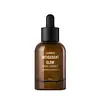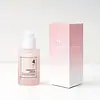What's inside
What's inside
 Key Ingredients
Key Ingredients

 Benefits
Benefits

 Concerns
Concerns

No concerns
 Ingredients Side-by-side
Ingredients Side-by-side

Water
Skin ConditioningPropanediol
SolventButylene Glycol
HumectantNiacinamide
SmoothingMethylpropanediol
SolventPentylene Glycol
Skin Conditioning1,2-Hexanediol
Skin ConditioningIsopentyldiol
HumectantOctyldodeceth-16
EmulsifyingAlpha-Arbutin
AntioxidantGlyceryl Glucoside
HumectantGlycerin
HumectantCarbomer
Emulsion StabilisingAdenosine
Skin ConditioningAmmonium Acryloyldimethyltaurate/Vp Copolymer
Tocopherol
AntioxidantPanthenol
Skin ConditioningWithania Somnifera Root Extract
Skin ConditioningTromethamine
BufferingCentella Asiatica Leaf Extract
Skin ConditioningWater, Propanediol, Butylene Glycol, Niacinamide, Methylpropanediol, Pentylene Glycol, 1,2-Hexanediol, Isopentyldiol, Octyldodeceth-16, Alpha-Arbutin, Glyceryl Glucoside, Glycerin, Carbomer, Adenosine, Ammonium Acryloyldimethyltaurate/Vp Copolymer, Tocopherol, Panthenol, Withania Somnifera Root Extract, Tromethamine, Centella Asiatica Leaf Extract
Collagen Extract 73%
Skin ConditioningButylene Glycol
HumectantWater
Skin Conditioning1,2-Hexanediol
Skin ConditioningGlycerin
HumectantGlycereth-26
HumectantNiacinamide
SmoothingPEG-240/Hdi Copolymer Bis-Decyltetradeceth-20 Ether
StabilisingCaprylic/Capric Triglyceride
MaskingMethylpropanediol
SolventPolyglyceryl-3 Methylglucose Distearate
EmulsifyingHydroxyethyl Urea
HumectantCellulose Gum
Emulsion StabilisingDicaprylyl Ether
EmollientCaprylyl Methicone
Skin ConditioningGlyceryl Polymethacrylate
Glyceryl Stearate
EmollientRose Extract
Skin ConditioningWine Extract
AntioxidantSucrose
HumectantAdenosine
Skin ConditioningDisodium EDTA
Mineral Salts
Skin ConditioningSodium Hyaluronate
HumectantPotassium Laurate
EmulsifyingTocopherol
AntioxidantPotassium Hyaluronate
Skin ConditioningEthylhexylglycerin
Skin ConditioningHydrolyzed Elastin
EmollientHydrolyzed Keratin
HumectantHydrolyzed Silk
HumectantHyaluronic Acid
HumectantHydrolyzed Hyaluronic Acid
HumectantSodium Acetylated Hyaluronate
HumectantHydroxypropyltrimonium Hyaluronate
Sodium Hyaluronate Crosspolymer
HumectantDimethylsilanol Hyaluronate
HumectantCaprylyl Glycol
EmollientHydrogenated Lecithin
EmulsifyingSodium Phosphate
BufferingPalmitoyl Tripeptide-5
Skin ConditioningAcetyl Hexapeptide-8
HumectantOligopeptide-3
Skin ConditioningParfum
MaskingCollagen Extract 73%, Butylene Glycol, Water, 1,2-Hexanediol, Glycerin, Glycereth-26, Niacinamide, PEG-240/Hdi Copolymer Bis-Decyltetradeceth-20 Ether, Caprylic/Capric Triglyceride, Methylpropanediol, Polyglyceryl-3 Methylglucose Distearate, Hydroxyethyl Urea, Cellulose Gum, Dicaprylyl Ether, Caprylyl Methicone, Glyceryl Polymethacrylate, Glyceryl Stearate, Rose Extract, Wine Extract, Sucrose, Adenosine, Disodium EDTA, Mineral Salts, Sodium Hyaluronate, Potassium Laurate, Tocopherol, Potassium Hyaluronate, Ethylhexylglycerin, Hydrolyzed Elastin, Hydrolyzed Keratin, Hydrolyzed Silk, Hyaluronic Acid, Hydrolyzed Hyaluronic Acid, Sodium Acetylated Hyaluronate, Hydroxypropyltrimonium Hyaluronate, Sodium Hyaluronate Crosspolymer, Dimethylsilanol Hyaluronate, Caprylyl Glycol, Hydrogenated Lecithin, Sodium Phosphate, Palmitoyl Tripeptide-5, Acetyl Hexapeptide-8, Oligopeptide-3, Parfum
 Reviews
Reviews

Ingredients Explained
These ingredients are found in both products.
Ingredients higher up in an ingredient list are typically present in a larger amount.
1,2-Hexanediol is a synthetic liquid and another multi-functional powerhouse.
It is a:
- Humectant, drawing moisture into the skin
- Emollient, helping to soften skin
- Solvent, dispersing and stabilizing formulas
- Preservative booster, enhancing the antimicrobial activity of other preservatives
Adenosine is in every living organism. It is one of four components in nucleic acids that helps store our DNA.
Adenosine has many benefits when used. These benefits include hydrating the skin, smoothing skin, and reducing wrinkles. Once applied, adenosine increases collagen production. It also helps with improving firmness and tissue repair.
Studies have found adenosine may also help with wound healing.
In skincare products, Adenosine is usually derived from yeast.
Learn more about AdenosineButylene Glycol (or BG) is used within cosmetic products for a few different reasons:
Overall, Butylene Glycol is a safe and well-rounded ingredient that works well with other ingredients.
Though this ingredient works well with most skin types, some people with sensitive skin may experience a reaction such as allergic rashes, closed comedones, or itchiness.
Learn more about Butylene GlycolGlycerin is already naturally found in your skin. It helps moisturize and protect your skin.
A study from 2016 found glycerin to be more effective as a humectant than AHAs and hyaluronic acid.
As a humectant, it helps the skin stay hydrated by pulling moisture to your skin. The low molecular weight of glycerin allows it to pull moisture into the deeper layers of your skin.
Hydrated skin improves your skin barrier; Your skin barrier helps protect against irritants and bacteria.
Glycerin has also been found to have antimicrobial and antiviral properties. Due to these properties, glycerin is often used in wound and burn treatments.
In cosmetics, glycerin is usually derived from plants such as soybean or palm. However, it can also be sourced from animals, such as tallow or animal fat.
This ingredient is organic, colorless, odorless, and non-toxic.
Glycerin is the name for this ingredient in American English. British English uses Glycerol/Glycerine.
Learn more about GlycerinMethylpropanediol is a synthetic solvent and humectant.
As a solvent, it helps dissolve other ingredients, helping to evenly distribute ingredients throughout the product. This ingredient has also been shown to have antimicrobial properties which makes it a preservative booster.
Methylpropanediol is able to add a bit of moisture to the skin. It also helps other ingredients be better absorbed into the skin, such as salicylic acid.
Learn more about MethylpropanediolNiacinamide is a multitasking form of vitamin B3 that strengthens the skin barrier, reduces pores and dark spots, regulates oil, and improves signs of aging.
And the best part? It's gentle and well-tolerated by most skin types, including sensitive and reactive skin.
You might have heard of "niacin flush", or the reddening of skin that causes itchiness. Niacinamide has not been found to cause this.
In very rare cases, some individuals may not be able to tolerate niacinamide at all or experience an allergic reaction to it.
If you are experiencing flaking, irritation, and dryness with this ingredient, be sure to double check all your products as this ingredient can be found in all categories of skincare.
When incorporating niacinamide into your routine, look out for concentration amounts. Typically, 5% niacinamide provides benefits such as fading dark spots. However, if you have sensitive skin, it is better to begin with a smaller concentration.
When you apply niacinamide to your skin, your body converts it into nicotinamide adenine dinucleotide (NAD). NAD is an essential coenzyme that is already found in your cells as "fuel" and powers countless biological processes.
In your skin, NAD helps repair cell damage, produce new healthy cells, support collagen production, strengthen the skin barrier, and fight environmental stressors (like UV and pollution).
Our natural NAD levels start to decline with age, leading to slower skin repair, visible aging, and a weaker skin barrier. By providing your skin niacinamide, you're recharging your skin's NAD levels. This leads to stronger, healthier, and younger looking skin.
Another name for vitamin B3 is nicotinamide. This vitamin is water-soluble and our bodies don't store it. We obtain Vitamin B3 from either food or skincare. Meat, fish, wheat, yeast, and leafy greens contain vitamin B3.
The type of niacinamide used in skincare is synthetically created.
Learn more about NiacinamideTocopherol (also known as Vitamin E) is a common antioxidant used to help protect the skin from free-radicals and strengthen the skin barrier. It's also fat soluble - this means our skin is great at absorbing it.
Vitamin E also helps keep your natural skin lipids healthy. Your lipid skin barrier naturally consists of lipids, ceramides, and fatty acids. Vitamin E offers extra protection for your skin’s lipid barrier, keeping your skin healthy and nourished.
Another benefit is a bit of UV protection. Vitamin E helps reduce the damage caused by UVB rays. (It should not replace your sunscreen). Combining it with Vitamin C can decrease sunburned cells and hyperpigmentation after UV exposure.
You might have noticed Vitamin E + C often paired together. This is because it is great at stabilizing Vitamin C. Using the two together helps increase the effectiveness of both ingredients.
There are often claims that Vitamin E can reduce/prevent scarring, but these claims haven't been confirmed by scientific research.
Learn more about TocopherolWater. It's the most common cosmetic ingredient of all. You'll usually see it at the top of ingredient lists, meaning that it makes up the largest part of the product.
So why is it so popular? Water most often acts as a solvent - this means that it helps dissolve other ingredients into the formulation.
You'll also recognize water as that liquid we all need to stay alive. If you see this, drink a glass of water. Stay hydrated!
Learn more about Water